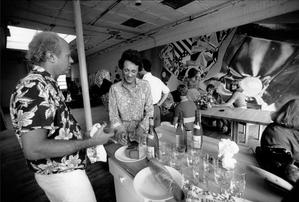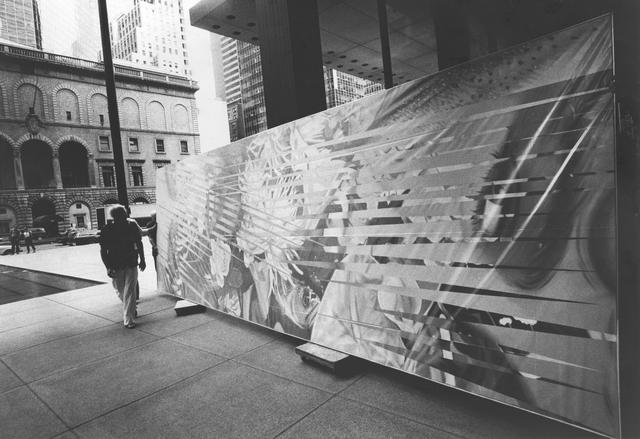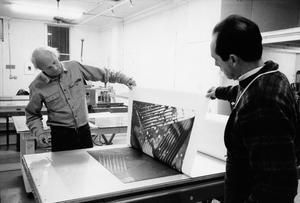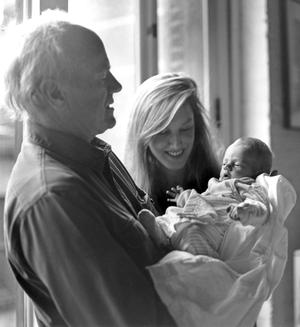
Rosenquist and Joan Mondale, Chambers Street studio, New York, 1980.
1980
Rosenquist participates in a conference, the Business of Art and the Artists, at the American Museum of Natural History, New York, sponsored by the National Endowment for the Arts and the Small Business Administration. He travels to Israel with Judith Goldman and Carolyn Alexander to give a lecture on printmaking at an exhibition sponsored by the United States Information Agency: Print Publishing in America.23 At his Chambers Street studio, Rosenquist paints Star Thief, whose dimensions, seventeen-by-forty-six feet, will become a standard for a number of later Rosenquist works. The creation of the painting—from blank canvas to completed work—is documented by photographer Bob Adelman over a period of five weeks; in February 1981 the photographs will be featured in an eleven-page color article in Life magazine entitled “Evolution of a Painting.”
1981
In January, Star Thief (1980) is exhibited at the Leo Castelli Gallery, New York, and is subsequently selected by the Dade County Art in Public Spaces Committee for installation in Terminal Two of Miami International Airport. The painting is not installed in the concourse due to resistance from Eastern Airlines—the main tenant of Terminal Two—when Frank Borman, former astronaut and chairman of Eastern Airlines, strongly rejects the painting. A private collector in Chicago (Burton Kantor, a tax attorney) will eventually purchase the painting for an undisclosed sum. (The painting
is ultimately acquired by the Museum Ludwig in Cologne, Germany, for the permanent collection.) Rosenquist receives an Honorary Doctorate of Fine Arts from the University of South Florida, Tampa. He produces The Glass Wishes series of aquatints at Gemini G.E.L.
1982
The La Jolla Museum of Contemporary Art in California presents Castelli and His Artists: Twenty-five Years, which is organized by the Aspen Center for the Visual Arts, Colorado, and features work by eighteen artists including Rosenquist, Roy Lichtenstein, Robert Rauschenberg, and Andy Warhol. In New York the Leo Castelli Gallery mounts New Works by Gallery Artists, which includes paintings by Rosenquist.
1983
In March construction is complete on a large, naturally lit studio on Rosenquist’s property in Aripeka, Florida. His lithograph Ice Point—which incorporates a slivered image of a woman’s face on a starry white background—is published by Visconti/Laxo Vujic in the portfolio Art and Sport to commemorate the upcoming 1984 Winter Olympics in Sarajevo, Yugoslavia.
1984
Alex von Bidder, Paul Kovi, and Tom Margittai, owners of the Four Seasons restaurant in the Seagram Building, New York, commission Rosenquist to create a painting in honor of the restaurant’s twenty-fifth year of service. The resulting seven-and-one-half-by-twenty-four-foot painting Flowers, Fish and Females for the Four Seasons (1984) is installed in the east corner of the Pool Room, the restaurant’s main dining room. The French automobile manufacturer Renault Automobile Co. commissions Rosenquist to paint a mural for the Fondation l’Incitation, Paris; Eau du Robot (1984) is Rosenquist’s response.

Rosenquist with Fish, Flowers and Females for the Four Seasons, 1984, while it is being transported into the Seagram Building, New York, 1984
1985
The Denver Art Museum organizes the retrospective James Rosenquist: Paintings 1961–1985, curated by Dianne Perry Vanderlip. The exhibition travels to the Contemporary Arts Museum, Houston; the Des Moines Art Center; the Albright-Knox Art Gallery, Buffalo; the Whitney Museum of American Art, New York; and the National Museum of American Art, Smithsonian Institution, Washington, D.C. Rosenquist completes Sunshot, a mural commissioned for the lobby of the Ashley Tower in Tampa, Florida.
1986
The Scull Collection, including Rosenquist’s Portrait of the Scull Family (1962) and F-111 (1964–65), is sold at Sotheby’s Contemporary Art Auction on November 11 and 12. Sold for just over two million dollars, the highest amount ever paid for a Rosenquist work at auction up to that point, F-111 is subsequently installed in the lobby of the Society Bank tower in downtown Cleveland. Rosenquist creates the mural Ladies of the Opera Terrace, which is a commission for the Opera Terrace, a ballroom located within the Operakällaren restaurant at Stockholm’s opera house.24 He is
also commissioned to paint a mural for AT&T Headquarters in Manhattan. When the painting, Animal Screams (1986), is finished, AT&T abandons the commission, and the work is sold to a group of businessmen in Sweden.
1987
Rosenquist finishes the print series Secrets in Carnations, at Graphicstudio/University of South Florida, Tampa. Begun in 1986, the series comprises five prints—including The Kabuki Blushes—that incorporate interspliced or “crosshatched” images of women and plants. In April, Rosenquist marries painter and writer Mimi Thompson. Representing the Florida Department of State and the Florida Arts Council, Secretary of State George Firestone presents Rosenquist with the Florida Arts Recognition Award on May 6. Rosenquist completes the mural Welcome to the Water Planet, which is a commission for the Corporate Property Investors building in Atlanta. He begins working on a related series of nine lithographic and handmade-paper-pulp works at Tyler Graphics Ltd. in Bedford Village,
New York. At Graphicstudio he likewise creates the related large-scale aquatints Welcome to the Water Planet and The Prickly Dark, which use a grisaille palette to great effect.

Rosenquist and Bill Goldston working on The Persistence of Electrons in Space at Universal Limited Art Editions, West Islip, New York, 1987.
1988
Rosenquist receives the Golden Plate Award from the American Academy of Achievement, Nashville, on July 2. To fulfill a commission from McDonald’s Swedish Corporation, Rosenquist paints the mural Welcome to the Water Planet III. Leo Castelli Gallery features Rosenquist’s seventeen-by-forty-six-foot painting Through the Eye of the Needle to the Anvil (1988) in an exhibition of the same name.
1989
In November, Rosenquist’s daughter, Lily, is born in New York. He completes the Welcome to the Water Planet series with Kenneth Tyler at Tyler’s new studio, Tyler Graphics Ltd., in Mount Kisco, New York. On Rosenquist’s property in Aripeka, Florida, construction is completed on his second naturally lit studio, which incorporates steel girders and corrugated-metal walls approaching industrial scale. He adapts a mobile hydraulic lift to work at various heights on large-scale canvases.

Rosenquist with his wife, Mimi Thompson, with their newborn daughter, Lily, Chambers Street studio, New York, 1989